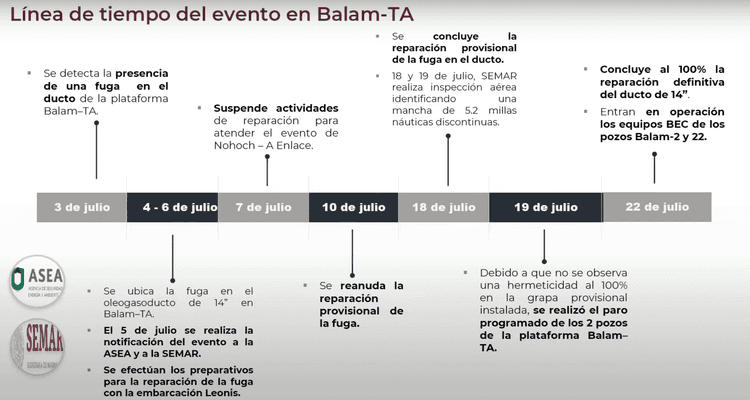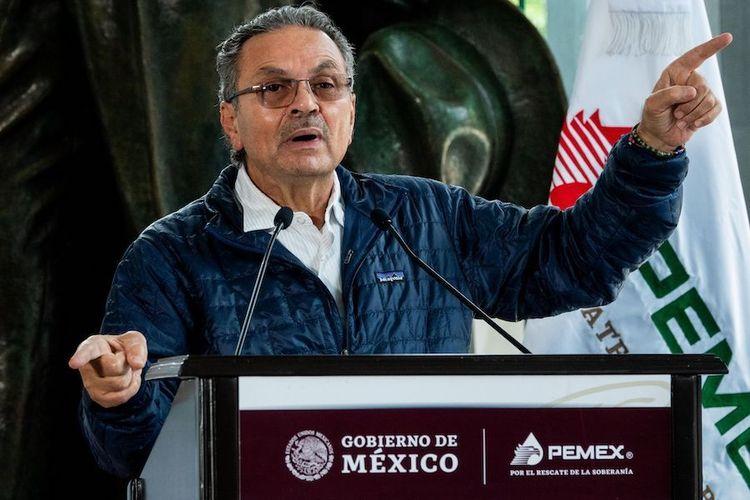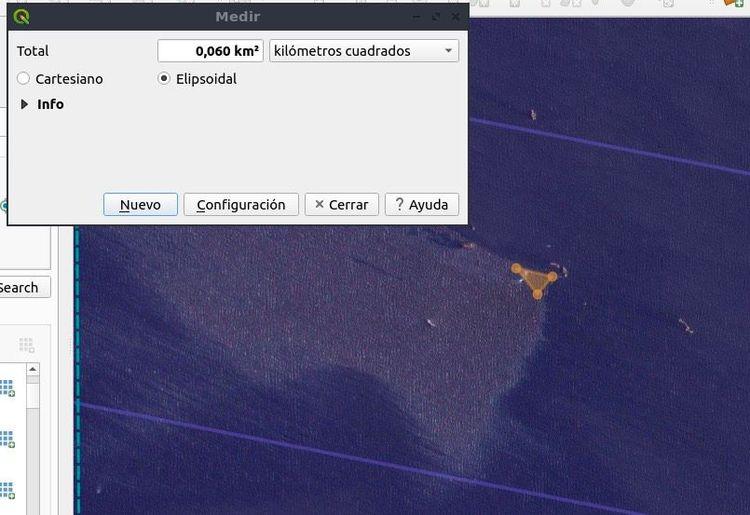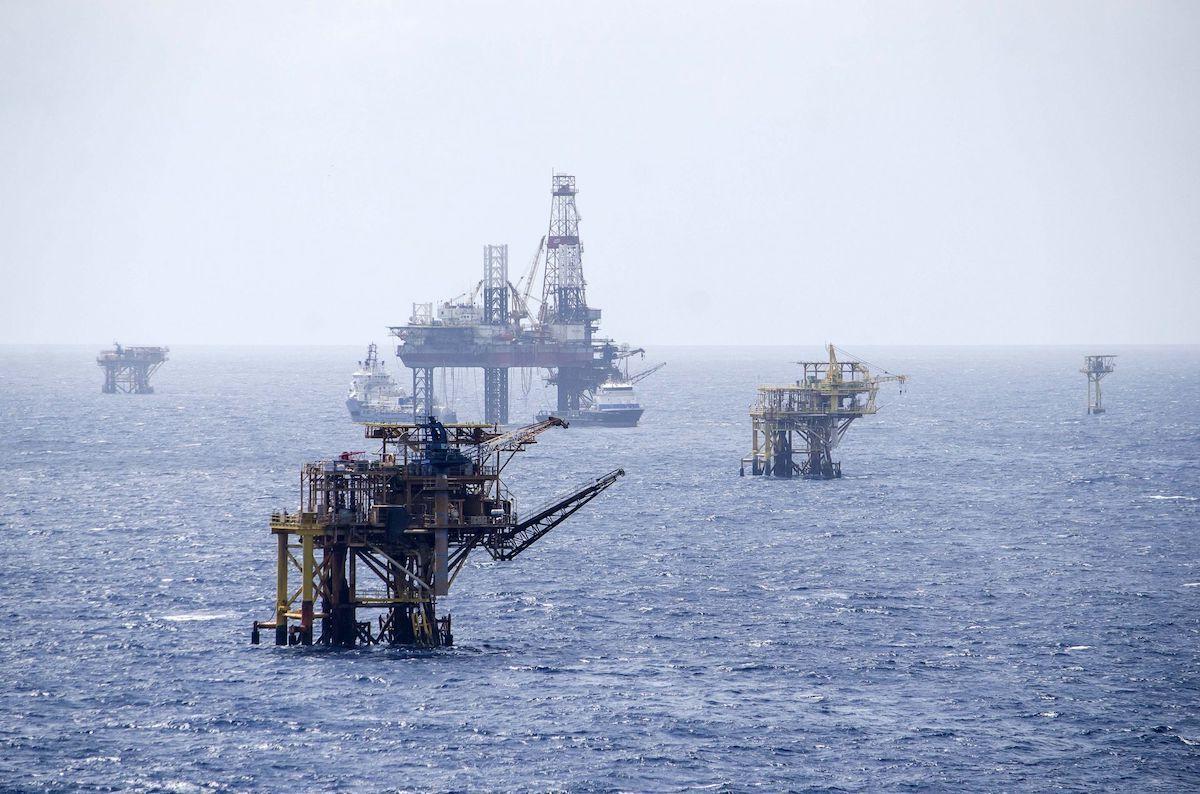Petrleos Mexicanos (Pemex) prioritized production over attention to the Campeche Sonda spill, said Pablo Montaño, general coordinator of the civil organization Climate Connections, after the oil company's lack of transparency about two spills reported last month by a group of more than 20 civil organizations.
The specialist pointed out that there is no reason why it took the oil company 16 days to cease production and repair the leak of this pipeline in the Campeche probe that would have started on July 3.

Timeline of attention to the Balam Tango Alpha escape from Pemex. Image: Pemex.
“If the possibility was to close the well because it doesn't close, what is the reason for this delay, then what can be inferred and I do this on a personal level is that I am prioritizing a production issue over a safety issue, it is prioritizing continuing production despite a spill,” Montaño said.
The oil company should have explained why it took so long to deal with the spill, he added.
According to the director of Pemex, Octavio Romero, repair of the leak was suspended on July 7 to deal with the Nohoch platform fire and resumed on July 19.
“It's important that before it continues, they realize that it's not heavy crude oil, it's light crude oil, what you see are very small thin sheets of oil, it's not a splash. And it's called iridescence because the sun's rays reflect them,” Romero said at a press conference on July 26.

Octavio Romero organized a press conference, where he spoke about iridescence in the sea. Image: Galo Cañas/Cuartoscuro.
A spill with a cumulative maximum of 1,368 barrels, or 76 barrels per day for the 18 days that the leak lasted, Pemex estimated. On the other hand, to achieve a layer of 467 square kilometers, as Pemex is accused, 3 million barrels would have had to be spilled, the oil company said at the conference.
Differences from the estimated area
The group of civil organizations reported on July 17 that this spill in the Campeche probe left a stain that was around 400 square kilometers, to which Pemex replied that it was actually an area of 0.06 square kilometers.

According to this image of civil organizations, the yellow triangle represents the size that Pemex holds of 0.06 km with respect to the rest of the stain. Photo: NGO press release.
The difference in the estimate of the affected area has meant that organizations will report that they will not consider Pemex's response as valid until it presents evidence, as they would have done with satellite and radar images.
In this way, a statement from Pemex and a conference by its director Octavio Romero have not yet resolved the doubts of the complainants of the spill.
“I think there is one key point that causes the most dissonance between what organizations are observing and that has been confirmed by the UNAM Institute of Geography itself, and that is the extent of a spill that Pemex insists on minimizing. In other words, Pemex talks about iridescence as if it didn't mean pollution,” Montaño said.
President Andrés Manuel López Obrador himself has added to the underestimation of the satellite images presented by civil organizations, he said that it was “a small leak of oil already dissolved, very, very small, nothing to do with what the Reform said, and continues to say”, at a conference on July 24.
According to Pemex, the size of the fracture detected on July 3 was seven centimeters, half of what a pen measures, and a width of one millimeter.
For Romero, the phenomenon of stains in Cantarell is due to “showers”, a natural phenomenon of hydrocarbon emanations, capable of leaving long stretches of iridescence.
However, the organizations pointed out on July 27 that their complaints have not been about this natural phenomenon but about escapes.
“The above-mentioned showers are more than 20 km from the vanishing point and are not
justify any type of additional discharge due to extractive activities,” they said in a statement.
Role of ASEA
The Security, Energy and Environment Agency (ASEA) released a statement on July 18 stating that it had been notified of the incident since July 6.
Asea noted that among the actions it took were: carrying out an overflight of the Ek-Balam fields, containment and cleaning actions, and the promise of precautionary measures to replace the facilities.
Montaño pointed out that the institution has not been as good as the attention it deserves.
“I think that ASEA has fallen far short of what its mandate indicates, that is, its mission is to oversee industrial and operational safety and the protection of the environment, that is the description of ASEA. However, what we are seeing here is that it is an agency that is simply endorsing what the company is saying and doing, considering Pemex, as a company, that is, Asea would have to evaluate the impact and sanction the company, it would have to be regulating the impact that we are all seeing. Why isn't it doing it, that's something that this agency can be reproached for,” said the coordinator of Climate Connections.
The Silenced Spill
Although civil organizations reported at their first conference the existence of a spill that occurred in June and another in July, the authorities have made no mention of the first one. This would have covered 270 square kilometers.



Comentarios (0)